Ethical Culture Analysis of Uber: Business Ethics and Recommendations
VerifiedAdded on 2023/04/24
|8
|2204
|365
Report
AI Summary
This report provides an in-depth ethical culture analysis of Uber, examining the company's business practices and ethical challenges. It begins by defining business ethics and organizational ethics, setting the stage for a focused examination of Uber's corporate conduct. The report highlights a series of ethical issues faced by Uber, including scandals related to sexual harassment, discrimination, and aggressive competitive tactics, ultimately tarnishing its public image. The analysis delves into the concept of ethical culture within organizations, outlining Uber's vision, mission, and code of conduct. Despite these efforts, the report uncovers several ongoing ethical concerns, such as employee motivation, pricing mechanisms, and customer comfort. To address these issues, the report offers actionable recommendations, including fostering positive employee relations, developing a motivating remuneration plan, investing in innovation, and refining pricing strategies. The report concludes by emphasizing the advantages of ethical behavior and corporate social responsibility, such as increased profits, employee loyalty, and investor attraction, and suggests the implementation of a Chief Ethics Officer to oversee ethics-related matters. This report provides valuable insights into the importance of ethical conduct in the business world and its impact on corporate success.
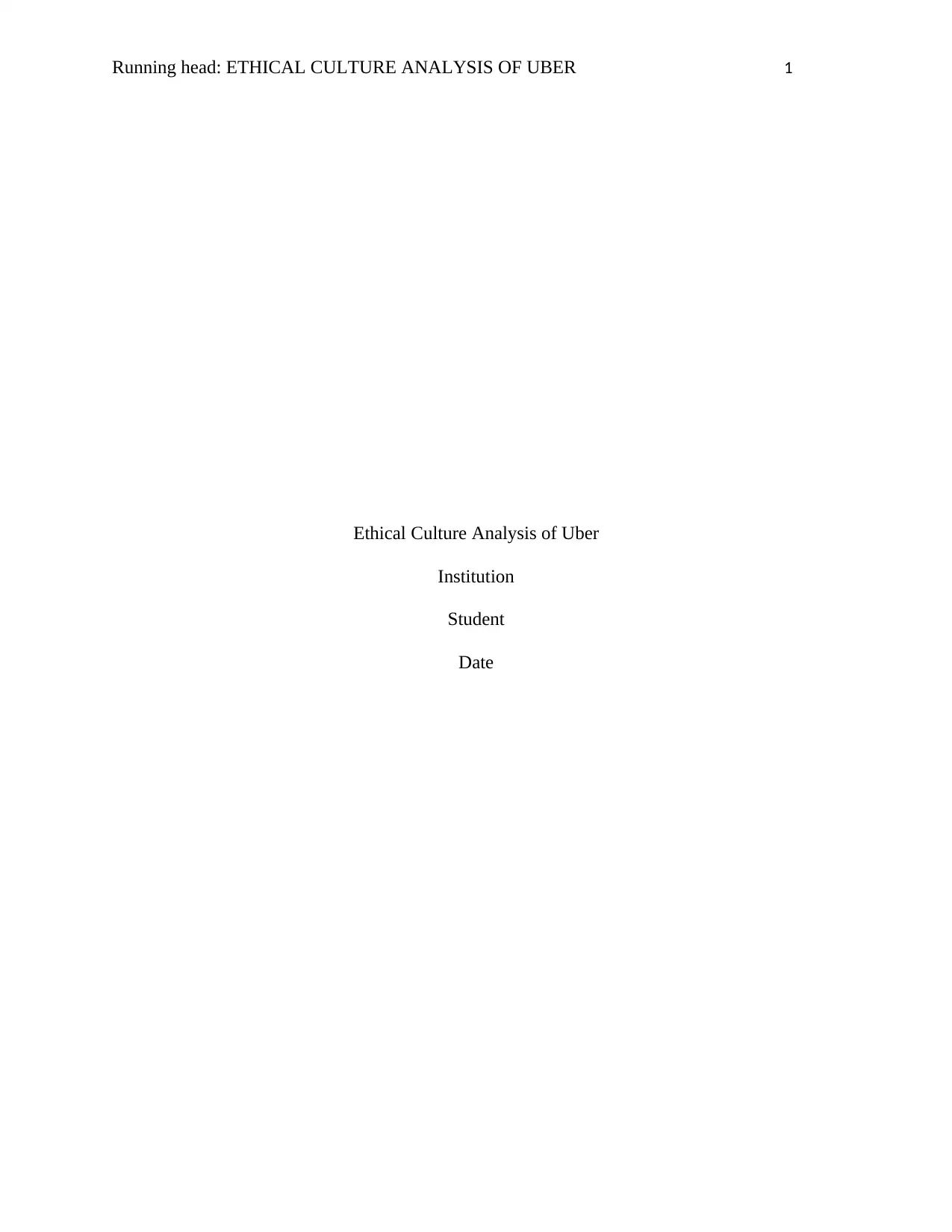
Running head: ETHICAL CULTURE ANALYSIS OF UBER 1
Ethical Culture Analysis of Uber
Institution
Student
Date
Ethical Culture Analysis of Uber
Institution
Student
Date
Paraphrase This Document
Need a fresh take? Get an instant paraphrase of this document with our AI Paraphraser
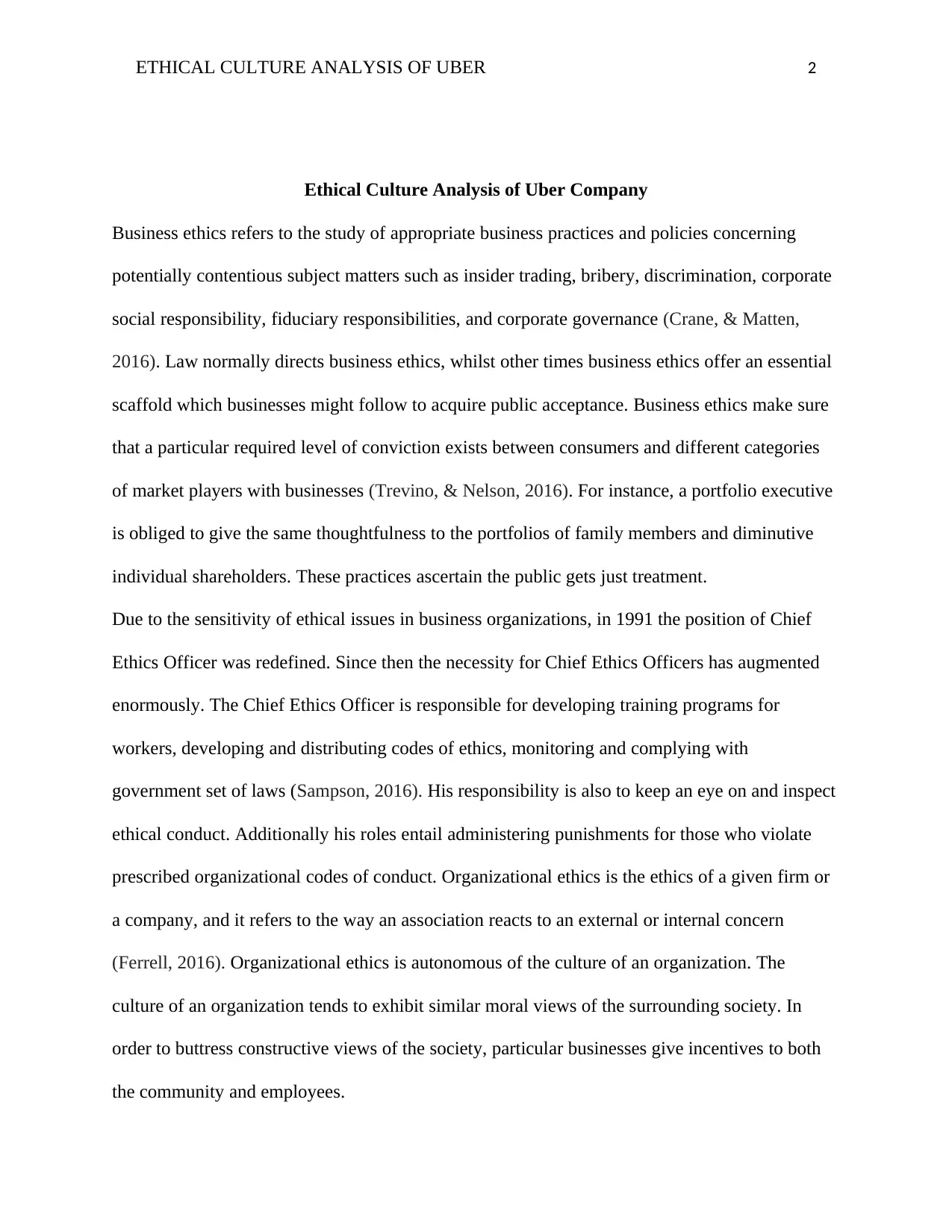
ETHICAL CULTURE ANALYSIS OF UBER 2
Ethical Culture Analysis of Uber Company
Business ethics refers to the study of appropriate business practices and policies concerning
potentially contentious subject matters such as insider trading, bribery, discrimination, corporate
social responsibility, fiduciary responsibilities, and corporate governance (Crane, & Matten,
2016). Law normally directs business ethics, whilst other times business ethics offer an essential
scaffold which businesses might follow to acquire public acceptance. Business ethics make sure
that a particular required level of conviction exists between consumers and different categories
of market players with businesses (Trevino, & Nelson, 2016). For instance, a portfolio executive
is obliged to give the same thoughtfulness to the portfolios of family members and diminutive
individual shareholders. These practices ascertain the public gets just treatment.
Due to the sensitivity of ethical issues in business organizations, in 1991 the position of Chief
Ethics Officer was redefined. Since then the necessity for Chief Ethics Officers has augmented
enormously. The Chief Ethics Officer is responsible for developing training programs for
workers, developing and distributing codes of ethics, monitoring and complying with
government set of laws (Sampson, 2016). His responsibility is also to keep an eye on and inspect
ethical conduct. Additionally his roles entail administering punishments for those who violate
prescribed organizational codes of conduct. Organizational ethics is the ethics of a given firm or
a company, and it refers to the way an association reacts to an external or internal concern
(Ferrell, 2016). Organizational ethics is autonomous of the culture of an organization. The
culture of an organization tends to exhibit similar moral views of the surrounding society. In
order to buttress constructive views of the society, particular businesses give incentives to both
the community and employees.
Ethical Culture Analysis of Uber Company
Business ethics refers to the study of appropriate business practices and policies concerning
potentially contentious subject matters such as insider trading, bribery, discrimination, corporate
social responsibility, fiduciary responsibilities, and corporate governance (Crane, & Matten,
2016). Law normally directs business ethics, whilst other times business ethics offer an essential
scaffold which businesses might follow to acquire public acceptance. Business ethics make sure
that a particular required level of conviction exists between consumers and different categories
of market players with businesses (Trevino, & Nelson, 2016). For instance, a portfolio executive
is obliged to give the same thoughtfulness to the portfolios of family members and diminutive
individual shareholders. These practices ascertain the public gets just treatment.
Due to the sensitivity of ethical issues in business organizations, in 1991 the position of Chief
Ethics Officer was redefined. Since then the necessity for Chief Ethics Officers has augmented
enormously. The Chief Ethics Officer is responsible for developing training programs for
workers, developing and distributing codes of ethics, monitoring and complying with
government set of laws (Sampson, 2016). His responsibility is also to keep an eye on and inspect
ethical conduct. Additionally his roles entail administering punishments for those who violate
prescribed organizational codes of conduct. Organizational ethics is the ethics of a given firm or
a company, and it refers to the way an association reacts to an external or internal concern
(Ferrell, 2016). Organizational ethics is autonomous of the culture of an organization. The
culture of an organization tends to exhibit similar moral views of the surrounding society. In
order to buttress constructive views of the society, particular businesses give incentives to both
the community and employees.
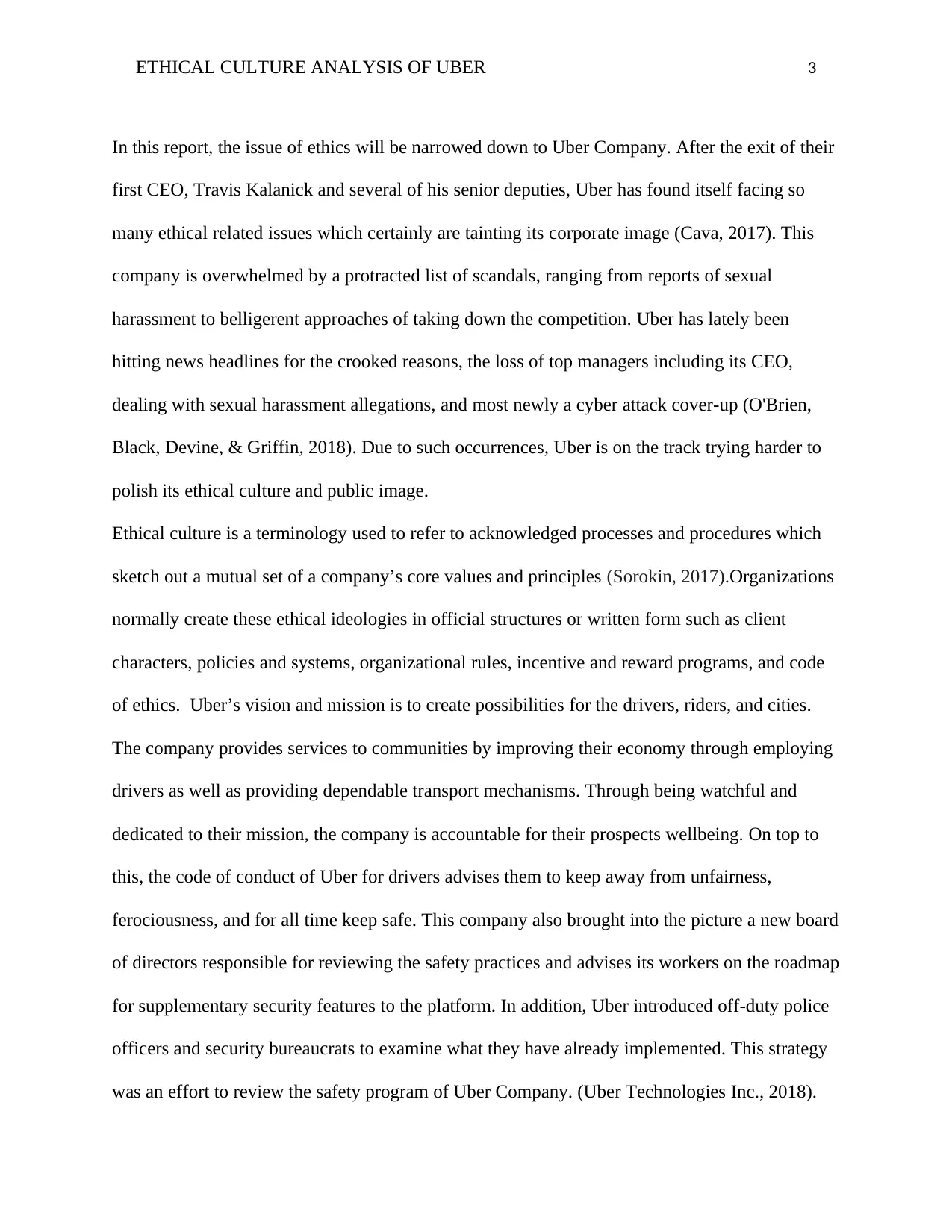
ETHICAL CULTURE ANALYSIS OF UBER 3
In this report, the issue of ethics will be narrowed down to Uber Company. After the exit of their
first CEO, Travis Kalanick and several of his senior deputies, Uber has found itself facing so
many ethical related issues which certainly are tainting its corporate image (Cava, 2017). This
company is overwhelmed by a protracted list of scandals, ranging from reports of sexual
harassment to belligerent approaches of taking down the competition. Uber has lately been
hitting news headlines for the crooked reasons, the loss of top managers including its CEO,
dealing with sexual harassment allegations, and most newly a cyber attack cover-up (O'Brien,
Black, Devine, & Griffin, 2018). Due to such occurrences, Uber is on the track trying harder to
polish its ethical culture and public image.
Ethical culture is a terminology used to refer to acknowledged processes and procedures which
sketch out a mutual set of a company’s core values and principles (Sorokin, 2017).Organizations
normally create these ethical ideologies in official structures or written form such as client
characters, policies and systems, organizational rules, incentive and reward programs, and code
of ethics. Uber’s vision and mission is to create possibilities for the drivers, riders, and cities.
The company provides services to communities by improving their economy through employing
drivers as well as providing dependable transport mechanisms. Through being watchful and
dedicated to their mission, the company is accountable for their prospects wellbeing. On top to
this, the code of conduct of Uber for drivers advises them to keep away from unfairness,
ferociousness, and for all time keep safe. This company also brought into the picture a new board
of directors responsible for reviewing the safety practices and advises its workers on the roadmap
for supplementary security features to the platform. In addition, Uber introduced off-duty police
officers and security bureaucrats to examine what they have already implemented. This strategy
was an effort to review the safety program of Uber Company. (Uber Technologies Inc., 2018).
In this report, the issue of ethics will be narrowed down to Uber Company. After the exit of their
first CEO, Travis Kalanick and several of his senior deputies, Uber has found itself facing so
many ethical related issues which certainly are tainting its corporate image (Cava, 2017). This
company is overwhelmed by a protracted list of scandals, ranging from reports of sexual
harassment to belligerent approaches of taking down the competition. Uber has lately been
hitting news headlines for the crooked reasons, the loss of top managers including its CEO,
dealing with sexual harassment allegations, and most newly a cyber attack cover-up (O'Brien,
Black, Devine, & Griffin, 2018). Due to such occurrences, Uber is on the track trying harder to
polish its ethical culture and public image.
Ethical culture is a terminology used to refer to acknowledged processes and procedures which
sketch out a mutual set of a company’s core values and principles (Sorokin, 2017).Organizations
normally create these ethical ideologies in official structures or written form such as client
characters, policies and systems, organizational rules, incentive and reward programs, and code
of ethics. Uber’s vision and mission is to create possibilities for the drivers, riders, and cities.
The company provides services to communities by improving their economy through employing
drivers as well as providing dependable transport mechanisms. Through being watchful and
dedicated to their mission, the company is accountable for their prospects wellbeing. On top to
this, the code of conduct of Uber for drivers advises them to keep away from unfairness,
ferociousness, and for all time keep safe. This company also brought into the picture a new board
of directors responsible for reviewing the safety practices and advises its workers on the roadmap
for supplementary security features to the platform. In addition, Uber introduced off-duty police
officers and security bureaucrats to examine what they have already implemented. This strategy
was an effort to review the safety program of Uber Company. (Uber Technologies Inc., 2018).
⊘ This is a preview!⊘
Do you want full access?
Subscribe today to unlock all pages.

Trusted by 1+ million students worldwide
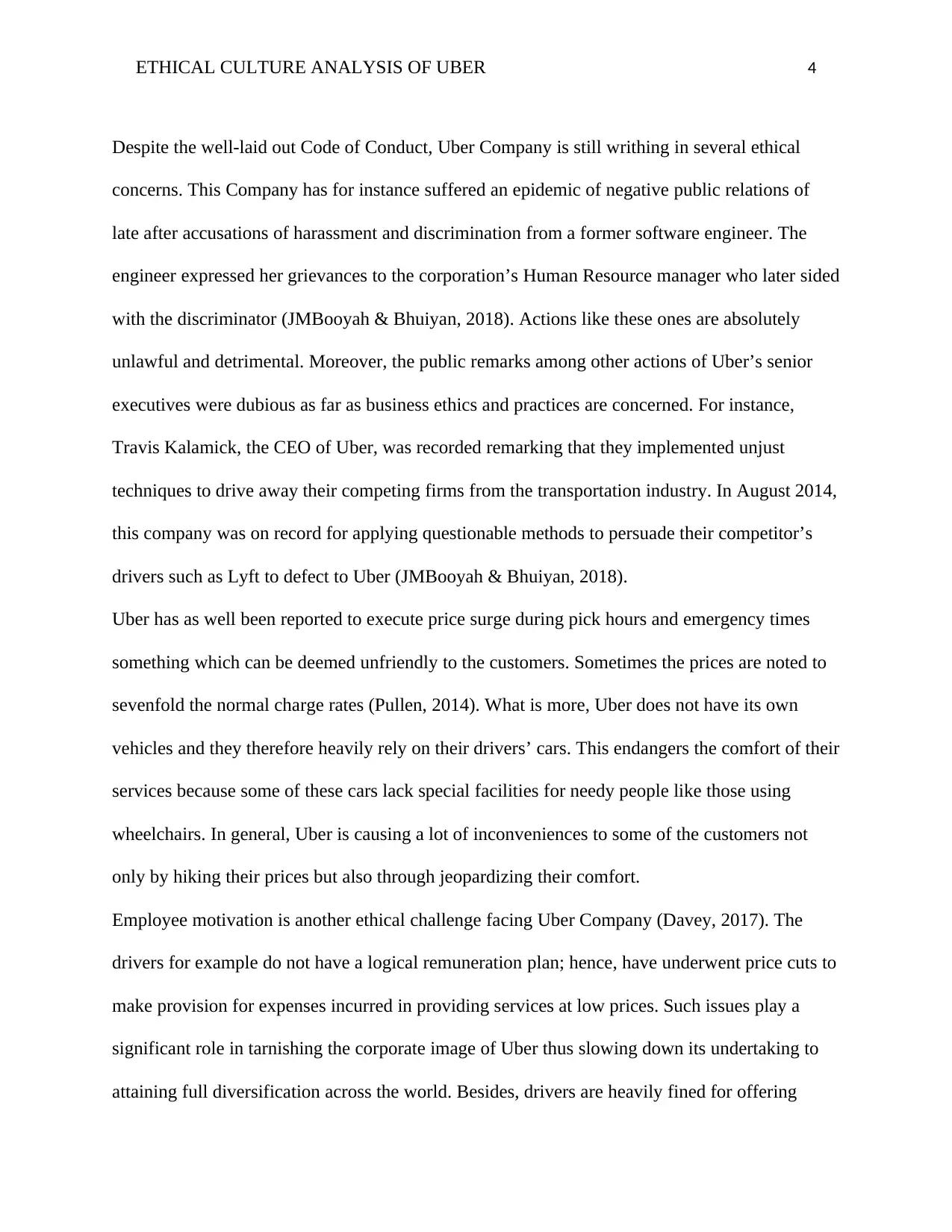
ETHICAL CULTURE ANALYSIS OF UBER 4
Despite the well-laid out Code of Conduct, Uber Company is still writhing in several ethical
concerns. This Company has for instance suffered an epidemic of negative public relations of
late after accusations of harassment and discrimination from a former software engineer. The
engineer expressed her grievances to the corporation’s Human Resource manager who later sided
with the discriminator (JMBooyah & Bhuiyan, 2018). Actions like these ones are absolutely
unlawful and detrimental. Moreover, the public remarks among other actions of Uber’s senior
executives were dubious as far as business ethics and practices are concerned. For instance,
Travis Kalamick, the CEO of Uber, was recorded remarking that they implemented unjust
techniques to drive away their competing firms from the transportation industry. In August 2014,
this company was on record for applying questionable methods to persuade their competitor’s
drivers such as Lyft to defect to Uber (JMBooyah & Bhuiyan, 2018).
Uber has as well been reported to execute price surge during pick hours and emergency times
something which can be deemed unfriendly to the customers. Sometimes the prices are noted to
sevenfold the normal charge rates (Pullen, 2014). What is more, Uber does not have its own
vehicles and they therefore heavily rely on their drivers’ cars. This endangers the comfort of their
services because some of these cars lack special facilities for needy people like those using
wheelchairs. In general, Uber is causing a lot of inconveniences to some of the customers not
only by hiking their prices but also through jeopardizing their comfort.
Employee motivation is another ethical challenge facing Uber Company (Davey, 2017). The
drivers for example do not have a logical remuneration plan; hence, have underwent price cuts to
make provision for expenses incurred in providing services at low prices. Such issues play a
significant role in tarnishing the corporate image of Uber thus slowing down its undertaking to
attaining full diversification across the world. Besides, drivers are heavily fined for offering
Despite the well-laid out Code of Conduct, Uber Company is still writhing in several ethical
concerns. This Company has for instance suffered an epidemic of negative public relations of
late after accusations of harassment and discrimination from a former software engineer. The
engineer expressed her grievances to the corporation’s Human Resource manager who later sided
with the discriminator (JMBooyah & Bhuiyan, 2018). Actions like these ones are absolutely
unlawful and detrimental. Moreover, the public remarks among other actions of Uber’s senior
executives were dubious as far as business ethics and practices are concerned. For instance,
Travis Kalamick, the CEO of Uber, was recorded remarking that they implemented unjust
techniques to drive away their competing firms from the transportation industry. In August 2014,
this company was on record for applying questionable methods to persuade their competitor’s
drivers such as Lyft to defect to Uber (JMBooyah & Bhuiyan, 2018).
Uber has as well been reported to execute price surge during pick hours and emergency times
something which can be deemed unfriendly to the customers. Sometimes the prices are noted to
sevenfold the normal charge rates (Pullen, 2014). What is more, Uber does not have its own
vehicles and they therefore heavily rely on their drivers’ cars. This endangers the comfort of their
services because some of these cars lack special facilities for needy people like those using
wheelchairs. In general, Uber is causing a lot of inconveniences to some of the customers not
only by hiking their prices but also through jeopardizing their comfort.
Employee motivation is another ethical challenge facing Uber Company (Davey, 2017). The
drivers for example do not have a logical remuneration plan; hence, have underwent price cuts to
make provision for expenses incurred in providing services at low prices. Such issues play a
significant role in tarnishing the corporate image of Uber thus slowing down its undertaking to
attaining full diversification across the world. Besides, drivers are heavily fined for offering
Paraphrase This Document
Need a fresh take? Get an instant paraphrase of this document with our AI Paraphraser
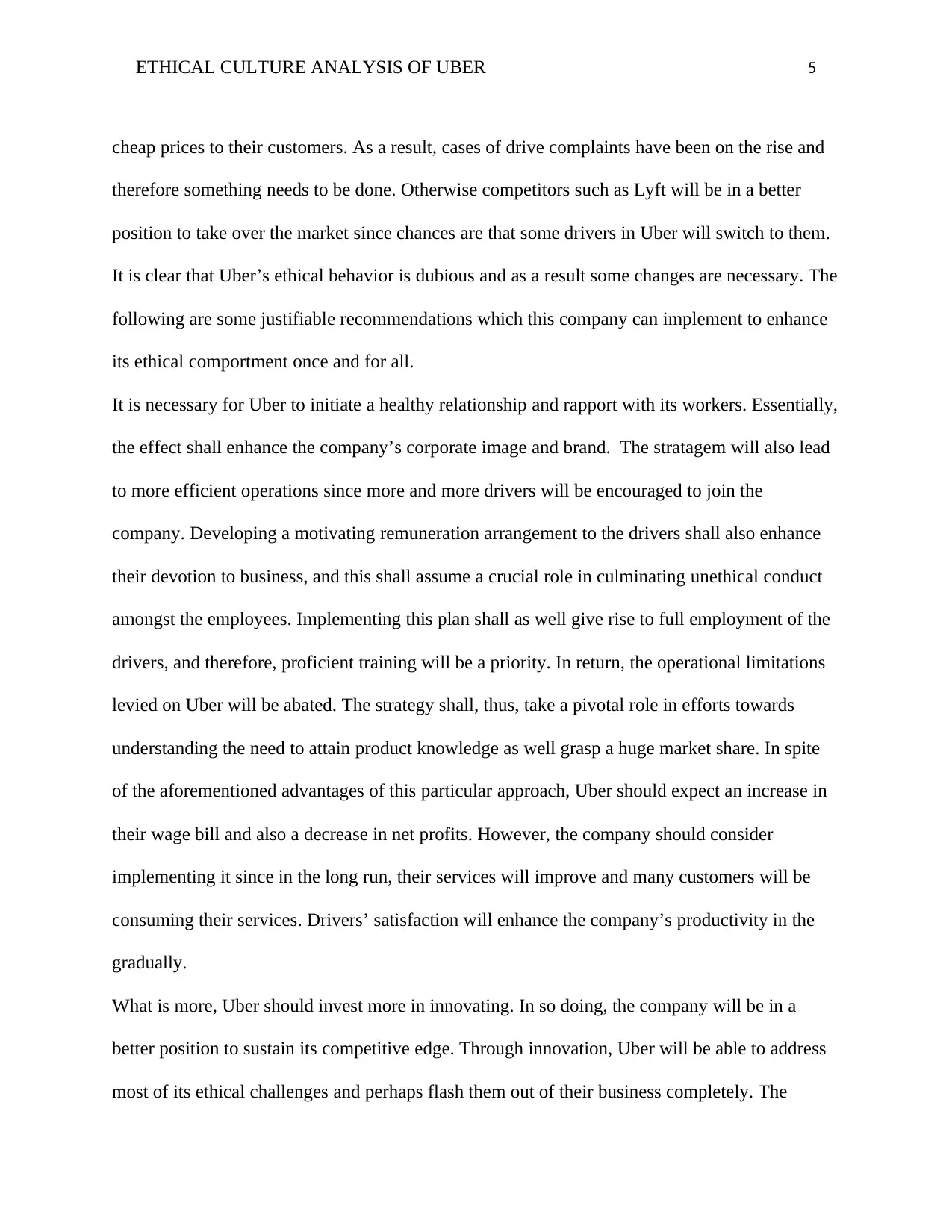
ETHICAL CULTURE ANALYSIS OF UBER 5
cheap prices to their customers. As a result, cases of drive complaints have been on the rise and
therefore something needs to be done. Otherwise competitors such as Lyft will be in a better
position to take over the market since chances are that some drivers in Uber will switch to them.
It is clear that Uber’s ethical behavior is dubious and as a result some changes are necessary. The
following are some justifiable recommendations which this company can implement to enhance
its ethical comportment once and for all.
It is necessary for Uber to initiate a healthy relationship and rapport with its workers. Essentially,
the effect shall enhance the company’s corporate image and brand. The stratagem will also lead
to more efficient operations since more and more drivers will be encouraged to join the
company. Developing a motivating remuneration arrangement to the drivers shall also enhance
their devotion to business, and this shall assume a crucial role in culminating unethical conduct
amongst the employees. Implementing this plan shall as well give rise to full employment of the
drivers, and therefore, proficient training will be a priority. In return, the operational limitations
levied on Uber will be abated. The strategy shall, thus, take a pivotal role in efforts towards
understanding the need to attain product knowledge as well grasp a huge market share. In spite
of the aforementioned advantages of this particular approach, Uber should expect an increase in
their wage bill and also a decrease in net profits. However, the company should consider
implementing it since in the long run, their services will improve and many customers will be
consuming their services. Drivers’ satisfaction will enhance the company’s productivity in the
gradually.
What is more, Uber should invest more in innovating. In so doing, the company will be in a
better position to sustain its competitive edge. Through innovation, Uber will be able to address
most of its ethical challenges and perhaps flash them out of their business completely. The
cheap prices to their customers. As a result, cases of drive complaints have been on the rise and
therefore something needs to be done. Otherwise competitors such as Lyft will be in a better
position to take over the market since chances are that some drivers in Uber will switch to them.
It is clear that Uber’s ethical behavior is dubious and as a result some changes are necessary. The
following are some justifiable recommendations which this company can implement to enhance
its ethical comportment once and for all.
It is necessary for Uber to initiate a healthy relationship and rapport with its workers. Essentially,
the effect shall enhance the company’s corporate image and brand. The stratagem will also lead
to more efficient operations since more and more drivers will be encouraged to join the
company. Developing a motivating remuneration arrangement to the drivers shall also enhance
their devotion to business, and this shall assume a crucial role in culminating unethical conduct
amongst the employees. Implementing this plan shall as well give rise to full employment of the
drivers, and therefore, proficient training will be a priority. In return, the operational limitations
levied on Uber will be abated. The strategy shall, thus, take a pivotal role in efforts towards
understanding the need to attain product knowledge as well grasp a huge market share. In spite
of the aforementioned advantages of this particular approach, Uber should expect an increase in
their wage bill and also a decrease in net profits. However, the company should consider
implementing it since in the long run, their services will improve and many customers will be
consuming their services. Drivers’ satisfaction will enhance the company’s productivity in the
gradually.
What is more, Uber should invest more in innovating. In so doing, the company will be in a
better position to sustain its competitive edge. Through innovation, Uber will be able to address
most of its ethical challenges and perhaps flash them out of their business completely. The
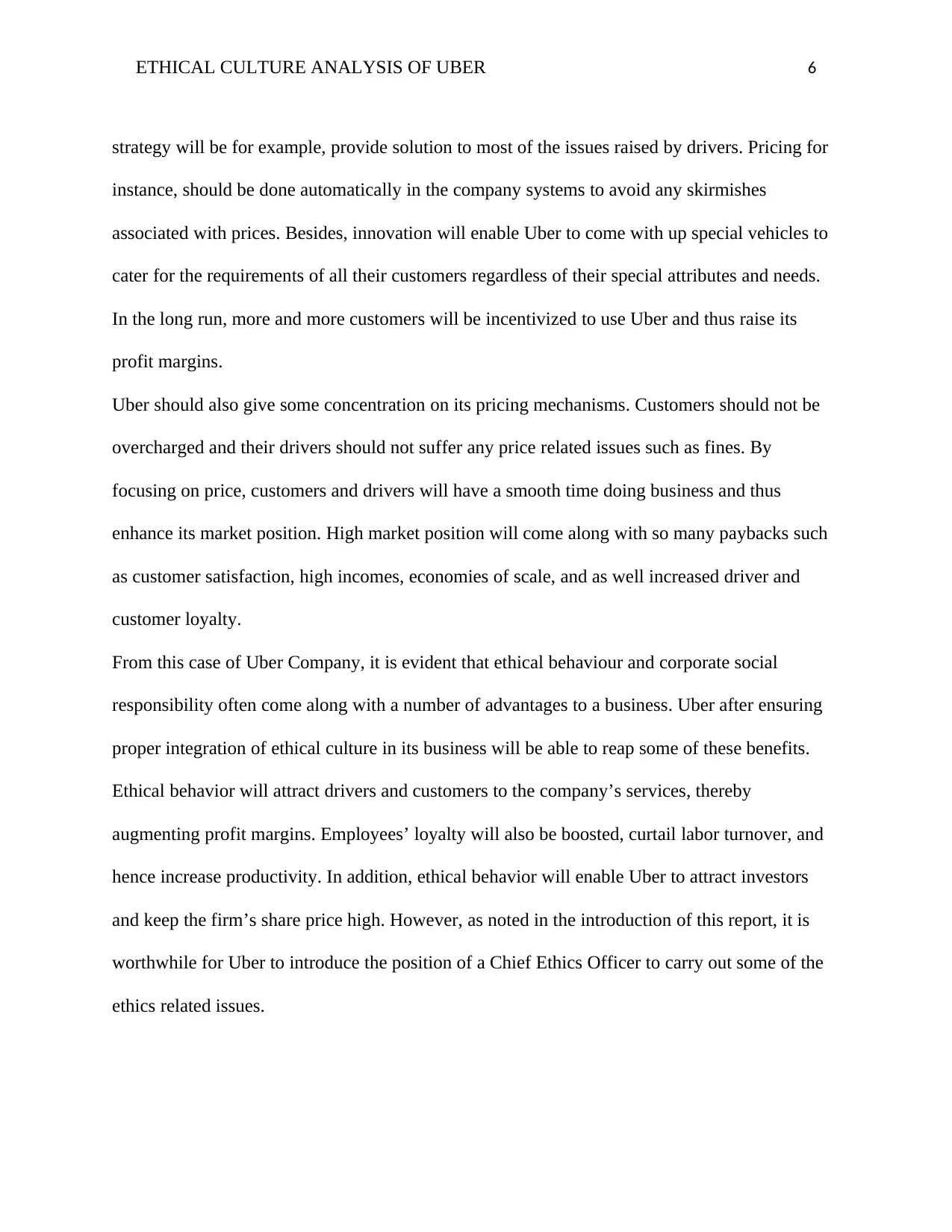
ETHICAL CULTURE ANALYSIS OF UBER 6
strategy will be for example, provide solution to most of the issues raised by drivers. Pricing for
instance, should be done automatically in the company systems to avoid any skirmishes
associated with prices. Besides, innovation will enable Uber to come with up special vehicles to
cater for the requirements of all their customers regardless of their special attributes and needs.
In the long run, more and more customers will be incentivized to use Uber and thus raise its
profit margins.
Uber should also give some concentration on its pricing mechanisms. Customers should not be
overcharged and their drivers should not suffer any price related issues such as fines. By
focusing on price, customers and drivers will have a smooth time doing business and thus
enhance its market position. High market position will come along with so many paybacks such
as customer satisfaction, high incomes, economies of scale, and as well increased driver and
customer loyalty.
From this case of Uber Company, it is evident that ethical behaviour and corporate social
responsibility often come along with a number of advantages to a business. Uber after ensuring
proper integration of ethical culture in its business will be able to reap some of these benefits.
Ethical behavior will attract drivers and customers to the company’s services, thereby
augmenting profit margins. Employees’ loyalty will also be boosted, curtail labor turnover, and
hence increase productivity. In addition, ethical behavior will enable Uber to attract investors
and keep the firm’s share price high. However, as noted in the introduction of this report, it is
worthwhile for Uber to introduce the position of a Chief Ethics Officer to carry out some of the
ethics related issues.
strategy will be for example, provide solution to most of the issues raised by drivers. Pricing for
instance, should be done automatically in the company systems to avoid any skirmishes
associated with prices. Besides, innovation will enable Uber to come with up special vehicles to
cater for the requirements of all their customers regardless of their special attributes and needs.
In the long run, more and more customers will be incentivized to use Uber and thus raise its
profit margins.
Uber should also give some concentration on its pricing mechanisms. Customers should not be
overcharged and their drivers should not suffer any price related issues such as fines. By
focusing on price, customers and drivers will have a smooth time doing business and thus
enhance its market position. High market position will come along with so many paybacks such
as customer satisfaction, high incomes, economies of scale, and as well increased driver and
customer loyalty.
From this case of Uber Company, it is evident that ethical behaviour and corporate social
responsibility often come along with a number of advantages to a business. Uber after ensuring
proper integration of ethical culture in its business will be able to reap some of these benefits.
Ethical behavior will attract drivers and customers to the company’s services, thereby
augmenting profit margins. Employees’ loyalty will also be boosted, curtail labor turnover, and
hence increase productivity. In addition, ethical behavior will enable Uber to attract investors
and keep the firm’s share price high. However, as noted in the introduction of this report, it is
worthwhile for Uber to introduce the position of a Chief Ethics Officer to carry out some of the
ethics related issues.
⊘ This is a preview!⊘
Do you want full access?
Subscribe today to unlock all pages.

Trusted by 1+ million students worldwide
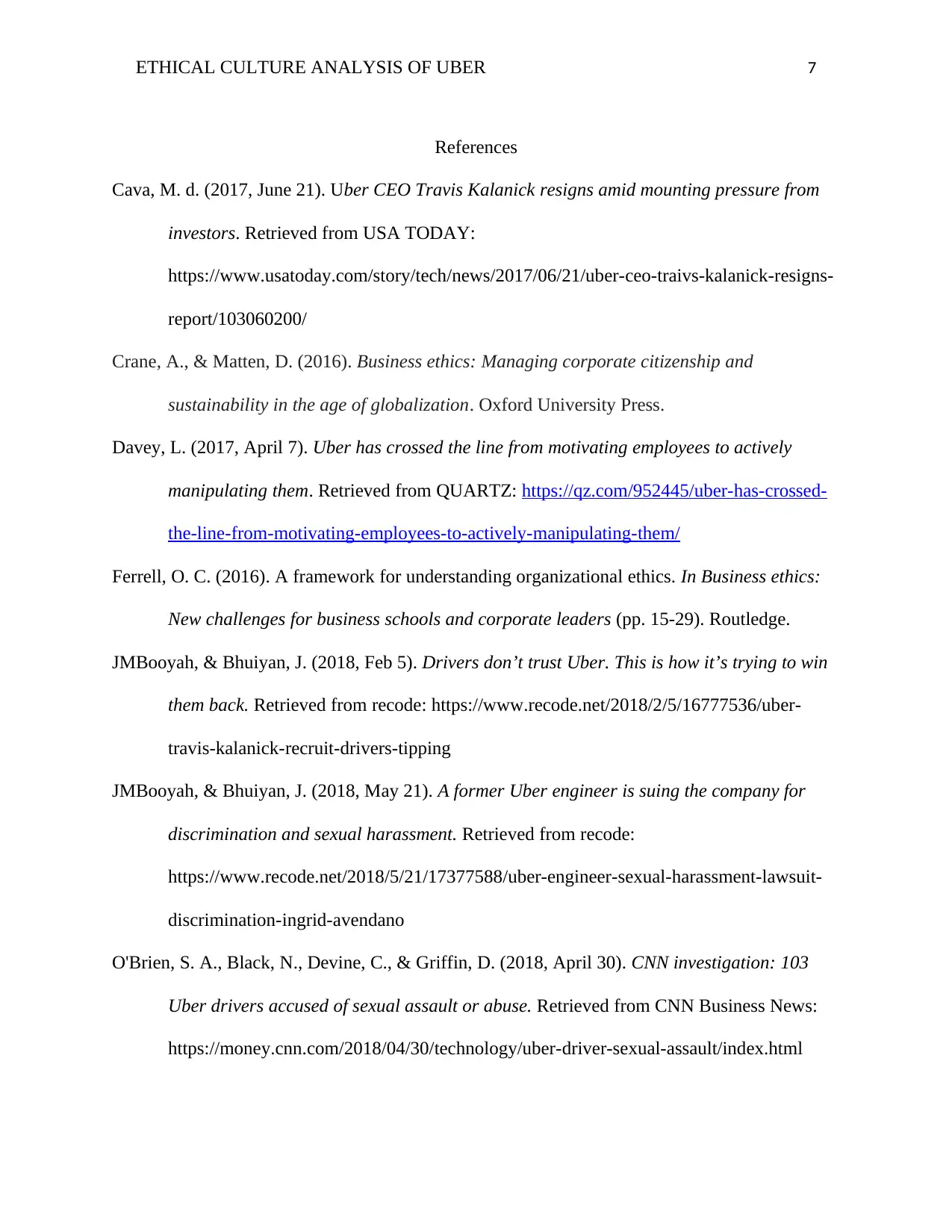
ETHICAL CULTURE ANALYSIS OF UBER 7
References
Cava, M. d. (2017, June 21). Uber CEO Travis Kalanick resigns amid mounting pressure from
investors. Retrieved from USA TODAY:
https://www.usatoday.com/story/tech/news/2017/06/21/uber-ceo-traivs-kalanick-resigns-
report/103060200/
Crane, A., & Matten, D. (2016). Business ethics: Managing corporate citizenship and
sustainability in the age of globalization. Oxford University Press.
Davey, L. (2017, April 7). Uber has crossed the line from motivating employees to actively
manipulating them. Retrieved from QUARTZ: https://qz.com/952445/uber-has-crossed-
the-line-from-motivating-employees-to-actively-manipulating-them/
Ferrell, O. C. (2016). A framework for understanding organizational ethics. In Business ethics:
New challenges for business schools and corporate leaders (pp. 15-29). Routledge.
JMBooyah, & Bhuiyan, J. (2018, Feb 5). Drivers don’t trust Uber. This is how it’s trying to win
them back. Retrieved from recode: https://www.recode.net/2018/2/5/16777536/uber-
travis-kalanick-recruit-drivers-tipping
JMBooyah, & Bhuiyan, J. (2018, May 21). A former Uber engineer is suing the company for
discrimination and sexual harassment. Retrieved from recode:
https://www.recode.net/2018/5/21/17377588/uber-engineer-sexual-harassment-lawsuit-
discrimination-ingrid-avendano
O'Brien, S. A., Black, N., Devine, C., & Griffin, D. (2018, April 30). CNN investigation: 103
Uber drivers accused of sexual assault or abuse. Retrieved from CNN Business News:
https://money.cnn.com/2018/04/30/technology/uber-driver-sexual-assault/index.html
References
Cava, M. d. (2017, June 21). Uber CEO Travis Kalanick resigns amid mounting pressure from
investors. Retrieved from USA TODAY:
https://www.usatoday.com/story/tech/news/2017/06/21/uber-ceo-traivs-kalanick-resigns-
report/103060200/
Crane, A., & Matten, D. (2016). Business ethics: Managing corporate citizenship and
sustainability in the age of globalization. Oxford University Press.
Davey, L. (2017, April 7). Uber has crossed the line from motivating employees to actively
manipulating them. Retrieved from QUARTZ: https://qz.com/952445/uber-has-crossed-
the-line-from-motivating-employees-to-actively-manipulating-them/
Ferrell, O. C. (2016). A framework for understanding organizational ethics. In Business ethics:
New challenges for business schools and corporate leaders (pp. 15-29). Routledge.
JMBooyah, & Bhuiyan, J. (2018, Feb 5). Drivers don’t trust Uber. This is how it’s trying to win
them back. Retrieved from recode: https://www.recode.net/2018/2/5/16777536/uber-
travis-kalanick-recruit-drivers-tipping
JMBooyah, & Bhuiyan, J. (2018, May 21). A former Uber engineer is suing the company for
discrimination and sexual harassment. Retrieved from recode:
https://www.recode.net/2018/5/21/17377588/uber-engineer-sexual-harassment-lawsuit-
discrimination-ingrid-avendano
O'Brien, S. A., Black, N., Devine, C., & Griffin, D. (2018, April 30). CNN investigation: 103
Uber drivers accused of sexual assault or abuse. Retrieved from CNN Business News:
https://money.cnn.com/2018/04/30/technology/uber-driver-sexual-assault/index.html
Paraphrase This Document
Need a fresh take? Get an instant paraphrase of this document with our AI Paraphraser
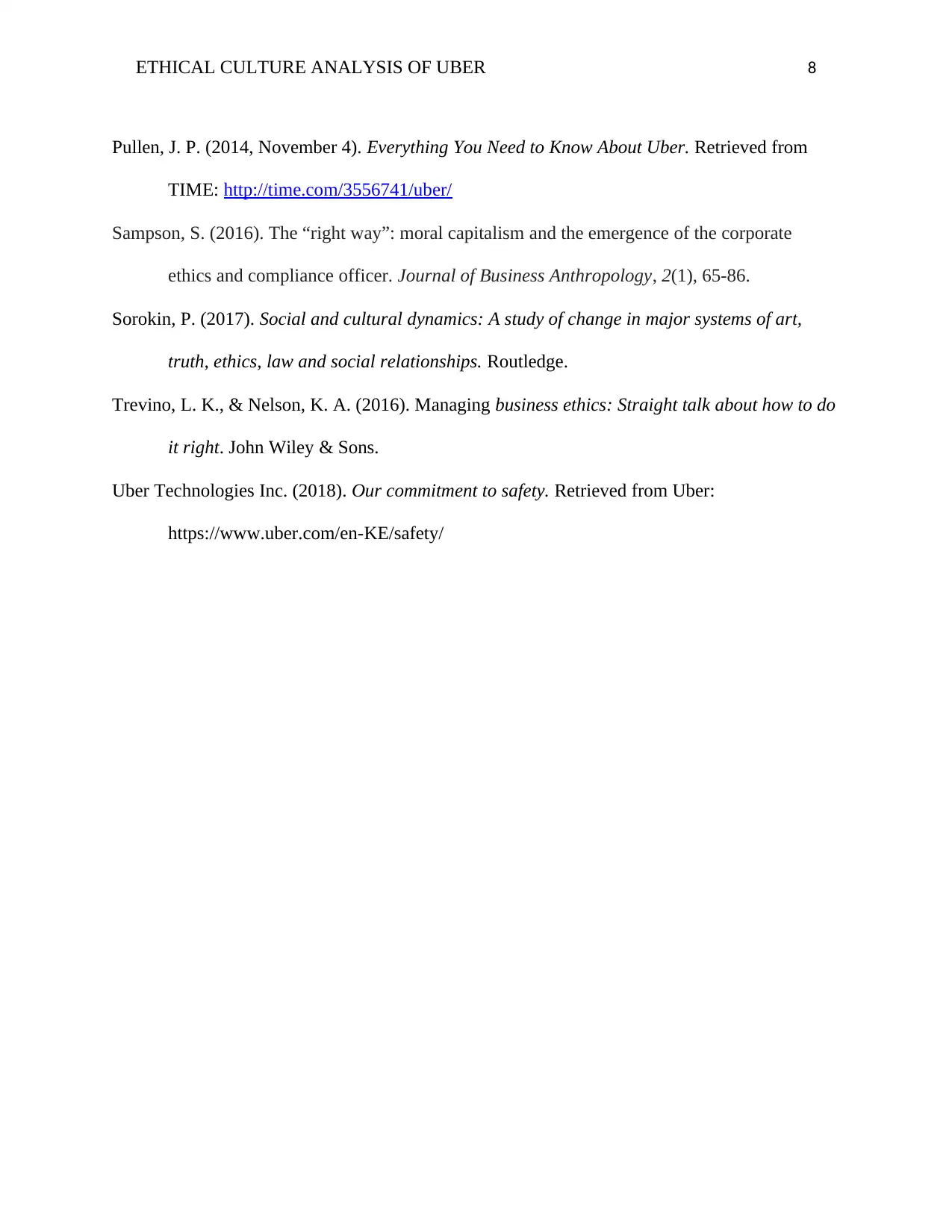
ETHICAL CULTURE ANALYSIS OF UBER 8
Pullen, J. P. (2014, November 4). Everything You Need to Know About Uber. Retrieved from
TIME: http://time.com/3556741/uber/
Sampson, S. (2016). The “right way”: moral capitalism and the emergence of the corporate
ethics and compliance officer. Journal of Business Anthropology, 2(1), 65-86.
Sorokin, P. (2017). Social and cultural dynamics: A study of change in major systems of art,
truth, ethics, law and social relationships. Routledge.
Trevino, L. K., & Nelson, K. A. (2016). Managing business ethics: Straight talk about how to do
it right. John Wiley & Sons.
Uber Technologies Inc. (2018). Our commitment to safety. Retrieved from Uber:
https://www.uber.com/en-KE/safety/
Pullen, J. P. (2014, November 4). Everything You Need to Know About Uber. Retrieved from
TIME: http://time.com/3556741/uber/
Sampson, S. (2016). The “right way”: moral capitalism and the emergence of the corporate
ethics and compliance officer. Journal of Business Anthropology, 2(1), 65-86.
Sorokin, P. (2017). Social and cultural dynamics: A study of change in major systems of art,
truth, ethics, law and social relationships. Routledge.
Trevino, L. K., & Nelson, K. A. (2016). Managing business ethics: Straight talk about how to do
it right. John Wiley & Sons.
Uber Technologies Inc. (2018). Our commitment to safety. Retrieved from Uber:
https://www.uber.com/en-KE/safety/
1 out of 8
Related Documents
Your All-in-One AI-Powered Toolkit for Academic Success.
+13062052269
info@desklib.com
Available 24*7 on WhatsApp / Email
![[object Object]](/_next/static/media/star-bottom.7253800d.svg)
Unlock your academic potential
Copyright © 2020–2025 A2Z Services. All Rights Reserved. Developed and managed by ZUCOL.





